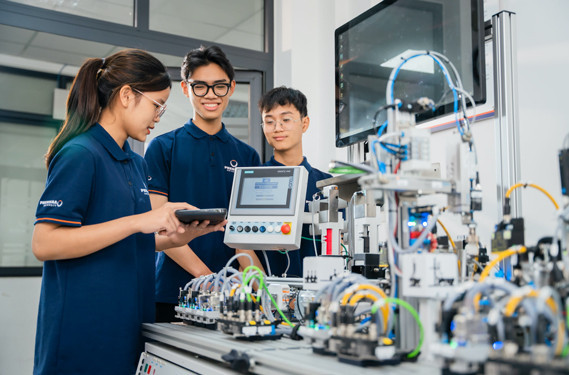Artificial intelligence education is becoming the new battleground between the United States and China. No longer a contest among labs and startups, it now begins in classrooms, with every child at the frontlines.
While China is rapidly executing a nationalized AI education strategy, the US - though slower to centralize - may gain momentum through its decentralized, innovation-rich education system.
This article does not aim to rank the two powers, but rather distills strategic highlights, reform trends in the US, current challenges, and key takeaways for Vietnam.
China: Root-level design, nationwide deployment

The AI race between the U.S. and China shows that education has become the foundation of national innovation. Illustration
China avoids overcomplicating its curriculum by integrating AI-related content into existing subjects like math, science, and technology. Elementary students learn computational thinking, middle schoolers begin basic programming and data analysis, and high schoolers tackle advanced topics like computer vision and machine learning.
The key lies in implementation. The central government leads policymaking and coordinates national resources. Tech giants like iFlytek and Baidu contribute software, learning materials, and classroom technologies. Elite universities such as Tsinghua and Fudan develop curricula, train teachers, and evaluate implementation quality.
China’s national AI learning platform enables equal access, even for students in remote or underdeveloped areas. Virtual assistant teachers personalize lessons, ensuring progress tailored to individual capacity - turning AI education policy into practical, inclusive infrastructure.
United States: Grassroots reform, private sector momentum
While China drives change top-down, the U.S. reshapes education from the ground up. Its decentralized model, once seen as a barrier to reform, now allows experimentation. In response to open letters from over 250 CEOs, tech leaders like Microsoft, Amazon, Meta, and NVIDIA have partnered with public schools to provide free AI learning platforms, teacher training, devices, and course modules.
Some districts - Lamar (Texas), Oakland (California), Baltimore (Maryland) - are piloting AI-integrated classrooms. Students learn at their own pace, guided by teachers overseeing progress. AI chatbots assist with math; computer vision supports biology labs; programming is taught through AI-enhanced games.
The federal government has formed an AI Education Task Force to standardize curricula, connect decentralized efforts, and remove regulatory barriers to private participation. Open learning repositories, teacher training hubs, and targeted funding for underserved areas are also underway.
While the U.S. cannot match China’s administrative speed, it leverages its innovation ecosystems, open educational resources, and local-level flexibility.
Challenges ahead
Both nations face profound obstacles - technical, social, and ethical - as AI permeates education.
Data privacy: AI tutors collect sensitive data on learning behaviors and emotional responses. Without proper legislation, companies could commercialize or manipulate this data.
Digital divide: In the U.S., disparities between wealthy and underfunded districts could worsen. In China, AI assistants are only effective where infrastructure exists, limiting rural impact.
Algorithmic bias: AI tools that suggest how to learn or answer may subtly encode bias, eroding students’ capacity for independent thinking - a cornerstone of democratic education.
To address these, the U.S. is developing the AI in Education Privacy Act, requiring algorithm transparency, end-to-end encryption, and banning third-party data sales. China, on the other hand, emphasizes state-controlled content but lacks independent civil oversight.
What can Vietnam learn?

Vietnam is just beginning to shape its AI education strategy. The key is not whether to follow the U.S. or China, but how to craft a path that matches its own infrastructure, demographics, and teacher capacity.
First, as in China, Vietnam can integrate AI content into existing courses without creating a new subject. The Ministry of Education should define AI competency benchmarks by education level. A national digital resource library would reduce rural-urban learning disparities.
Second, Vietnam can draw from the U.S. model by mobilizing the private sector. Companies like FPT, Viettel, VNPT, VNG, and CMC can act like U.S. tech giants - developing infrastructure and open-standard learning tools. Nationwide teacher training programs should be offered via MOOCs with certified credentials.
Third, Vietnam should consider a national coordinating body - perhaps a National AI Education Commission - to unify curricula, connect enterprises, schools, and government, and manage a centralized data system. However, it should operate with flexibility and transparency rather than rigid bureaucracy.
The AI race between the U.S. and China proves that education is now foundational to national innovation capacity. The U.S. capitalizes on private creativity and adaptive ecosystems; China excels in swift, synchronized policy execution.
Vietnam need not imitate either. What matters is to act now - embedding AI from primary school, training teachers at scale, ensuring access to learning devices, and building agile public-private coordination mechanisms.
AI won’t wait. Countries that delay risk falling irreversibly behind in the technological and educational race of the 21st century.
Hoang Anh Tuan
Ambassador, former ASEAN Deputy Secretary-General